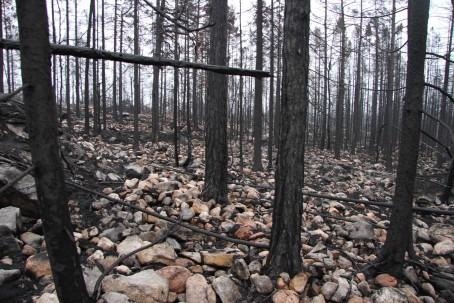Jun 2 2021
For four years, Swedish scientists from various institutions, which also included Uppsala University, have been collecting information from the regions impacted by the major forest fire that occurred in 2014.
 Hälleskogsbrännan, Västmanland, Sweden, three months after the fire in 2014. Almost all organic soil in the area was lost, which released large amounts of carbon and nitrogen. Image Credit: Joachim Strengbom.
Hälleskogsbrännan, Västmanland, Sweden, three months after the fire in 2014. Almost all organic soil in the area was lost, which released large amounts of carbon and nitrogen. Image Credit: Joachim Strengbom.
While investigating the changes made to the ecosystem as a whole, the researchers were able to see that the quality of water in watercourses rapidly returned to normal, whereas the forested regions continued to lose carbon for several years even after the fire. The repercussions of the significant forest fires were not extensively investigated in Northern Europe.
Hence, to improve this scenario, scientists from Uppsala University, the Swedish University of Agricultural Sciences (SLU), and the Swedish Meteorological and Hydrological Institute (SMHI) agreed to analyze the amount of nutrients and carbon discharged into the watercourses and the atmosphere during fires and how rapidly the ecosystem is restored to its original state.
The study results are currently being presented in Biogeosciences, a scientific journal.
The Swedish province, Västmanland, experienced a specifically ferocious fire in 2014, which burned both wetland and woodland. The trees survived only in a few regions.
It is not however the trees that release carbon during fires in coniferous forests. Only some of the needles and small branches up in the trees burn, while around 90% of losses come from organic soil, the so-called humus layer. Ditched peatlands that dry a great deal of organic material in the soil are therefore large point sources for emissions from the landscape.
Gustaf Granath, Study Lead Author and Researcher, Uppsala University
“This makes it important to measure how deep the burning goes in the ground in order to estimate carbon emissions after a forest fire. We had the opportunity to do just that over a wide area in Västmanland,” added Granath.
When the humus layer is lost, huge amounts of nitrogen and carbon are discharged from woodland and threatens other nutrients that leach out after the fire. Hence, it is crucial for vegetation to rapidly re-establish itself to support the retention of nutrients and the restoration of soil carbon.
The Västmanland results revealed that during the major fire, about 145 to 160 tons of carbon dioxide (CO2) was released into the air for every hectare. For the entire burned region, this corresponds to 10% of the CO2 produced each year by the domestic transport sector in Sweden.
Because of the dearth of vegetation after the major fire, the soil continued to lose carbon over the next several years, with an overall uptake of carbon initially observed at the time of a summer month three years after the forest fire.
Investigators were also concerned that in the wake of the fire, plenty of carbon would be lost to watercourses but they were not able to detect any such additional discharge of carbon into the streams when comparing conditions both before and after the fire.
However, amounts of nutrients, like phosphorus and nitrogen, certainly increased in lakes and streams after the major fire, and reached a peak in less than one to two months of the fire before decreasing over time.
For several of these substances, as much as five times were released during the initial year after the fire when compared to before the fire, but one to two years after the forest fire, a majority of values had returned to normal ones.
This rapid leaching of nutrients after the fire is due to the lack of vegetation that could absorb the substances, as well as the large release of the substances during the fire as organic soil burned. Without living vegetation and organic soil, water flows in streams increased by 50%.
Stephan Köhler, Professor of Environmental Geochemistry, The Swedish University of Agricultural Sciences
It was Köhler who initiated the measurement of water quality instantly after the fire.
Other research works have demonstrated how vegetation in the region of forest fires has re-established itself and how nutrient and carbon stocks have been rebuilt. But how rapidly this takes place and what process parameters will influence whether or not Swedish forests would turn out to be long-term sources of atmospheric CO2 is something the investigators intend to find out.
While we now know more about how much and where carbon and nutrients disappear in fires, what happens next is equally interesting. There is a great deal of carbon bound in dead trees that will soon begin to decompose, while at the same time the soil and vegetation will store new carbon and build up stocks of nitrogen. It’s important to follow this if we are to understand how our forests are affected when they burn.
Gustaf Granath, Study Lead Author and Researcher, Uppsala University
The study was financially supported by the Swedish Agency for Marine and Water Management and Formas.
Journal Reference:
Granath, G., et al. (2021) The impact of wildfire on biogeochemical fluxes and water quality in boreal catchments. Biogeosciences. doi.org/10.5194/bg-18-3243-2021.